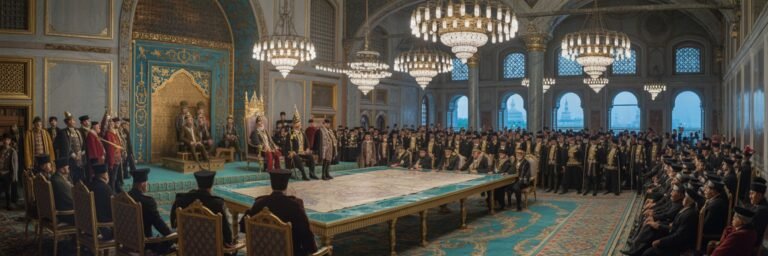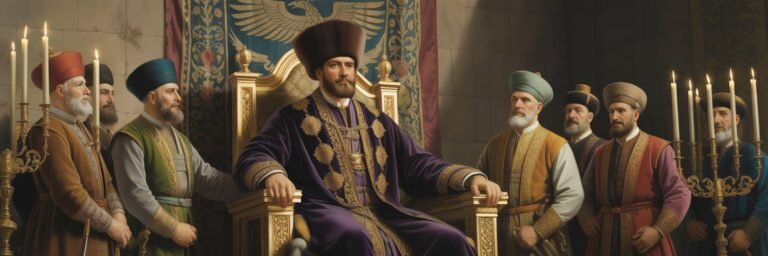INTRODUCTION
Famed for its religious tolerance, intricate bureaucracy, and military might, the Ottoman Empire housed countless flamboyant and infamous characters who shaped its destiny over the course of six centuries. From brilliant bureaucrats to sinister sultans, we trace the captivating tales of those revered and reviled in equal measure. This article paints a colorful portrait of these individuals–addressing their place in history, the theories and interpretations surrounding their lives, the controversies they were entangled in, and the symbolism they carry within Ottoman culture. Let us journey through the annals of Ottoman history, and the personalities who left an indelible imprint on this impressive empire.
HISTORICAL BACKGROUND
The Ottoman Empire’s saga started with its establishment in 1299 under Osman Gazi, a charismatic leader whose ambitions set the stage for one of the most significant and enduring empires in World History. By 1683, the Empire controlled a massive area, encompassing parts of Eastern Europe, Western Asia, and North Africa. Here, heroes and villains alike took center stage, their stories woven tightly into the Empire’s tapestry.
Suleiman the Magnificent, the tenth ruler of the Empire, exemplified the quintessential Ottoman ruler. He was fair, stern, and clever—balancing military expansion with societal development. His reign from 1520–1566 is widely regarded as the pinnacle of Ottoman power. However, on the other side of the moral spectrum stands Sultan Abdulhamid II, whose 33-year reign was synonymous with autocratic rule and relentless persecution. His reign from 1876–1909 scarred the Empire and contributed to its downfall.
THEORIES AND INTERPRETATIONS
Through the annals of history, the extreme characters, both virtuous and detestable, have given rise to much academic speculation and theories. One popular interpretation proposed by historian Bernard Lewis asserts that Suleiman’s victories were not simply his own, but a product of the established logistical and strategic structures of the Empire.
In stark contrast, scholars like George Young contend that Abdulhamid II was not just a malevolent ruler, but a reactionary caught in the tidal wave of modernization. Young portrays Abdulhamid II as a tragic figure—someone struggling to balance the shifting societal dynamics, religious factions, and the encroachment of Western influence.
The cases of Suleiman and Abdulhamid illustrate how theories and representations can either burnish or tarnish reputations, obscuring the complex human actions that underpin historical events.
MYSTERIES AND CONTROVERSIES
Ottoman history is rife with perplexing mysteries and controversies that challenge our understanding of these so-called heroes and villains. One of the most enduring controversies revolves around the execution of Suleiman’s popular eldest son, Mustafa, in 1553. Was it a cruel act of paranoia by a threatened Suleiman, or a calculated move to preserve the integrity of the Empire? Historians continue to speculate and debate over this grim event.
An even darker mystery surrounds the infamous Hamidian massacres (1894-1896) under Abdulhamid II. While the sultan’s culpability in the organized killing of Armenian Christians is widely accepted, the actual extent of his involvement remains shrouded in doubt.
SYMBOLISM AND CULTURAL SIGNIFICANCE
Just as the Empire’s streets were adorned with the grandeur of its architectural marvels, so too were its stories enriched by the symbolic figures who walked those same lanes. To many, Suleiman the Magnificent embodied the Empire’s golden age, symbolizing the harmonious blending of cultural diversity, artistic achievement, and military prowess. However, his political strategies and failures laced his legacy with darker shades.
Compare him to Abdulhamid II—a symbol of disastrous despotism and the disastrous erosion of Ottoman power. Despite his questionable tactics, Abdulhamid is also ironically perceived as a symbol of Ottoman resistance against Western imperialism.
MODERN INVESTIGATIONS
Modern research into the Ottoman Empire has helped to shed light on many obscured facts, but has also thrown up new challenges. The accessibility of Ottoman archives in Turkey to global researchers has led to an increase in the re-evaluation of key figures. For instance, scholars using these resources are now questioning whether the vilification of leaders like Abdulhamid II, albeit justified at times, led to the overlooking of their attempts at administrative reform.
Furthermore, modern historiography is increasingly focusing on the roles lesser-known individuals played in shaping the Empire. From Kosem Sultan, the influential woman of the harem, to Hezarfen Ahmet Celebi, the aviation pioneer, new heroes and villains continue to emerge from the depths of time.
LEGACY AND CONCLUSION
The Ottoman Empire’s legacy is indeed a panorama where its heroes and villains play crucial roles. The legends, tales, and the undeniable historical impact of such figures continue to shape how the Empire is perceived to this day.
Suleiman’s reign is remembered as a period of remarkable cultural and architectural development, establishing the template for Ottoman aesthetics and governance. Despite his brutal approach to power consolidation, he is regarded as the embodiment of Ottoman prosperity.
Conversely, Abdulhamid II, despite his infamous draconian rule, remains an intriguing figure. It was his forward-thinking initiatives, such as modernizing the education sector and infrastructure development, that provide an alternative perspective on his often-denigrated character.
These figures, and the Empire itself, compel us to appreciate the complexities of history—often interlaced between the threads of truth, interpretation, and myth. The dichotomy of heroes and villains becomes less glaring when we allow ourselves to perceive them within their historical context. Their actions, decisions, and legacies, whether noble or ignoble, form the rich tapestry of the long-lasting, vibrant, and paradoxical Ottoman Empire. Thus, the enduring fascination with the heroes and villains of the Ottoman Empire helps us unravel not just the mysteries of the past, but the lessons they provide for understanding societies, cultures, and leadership through the ages.






